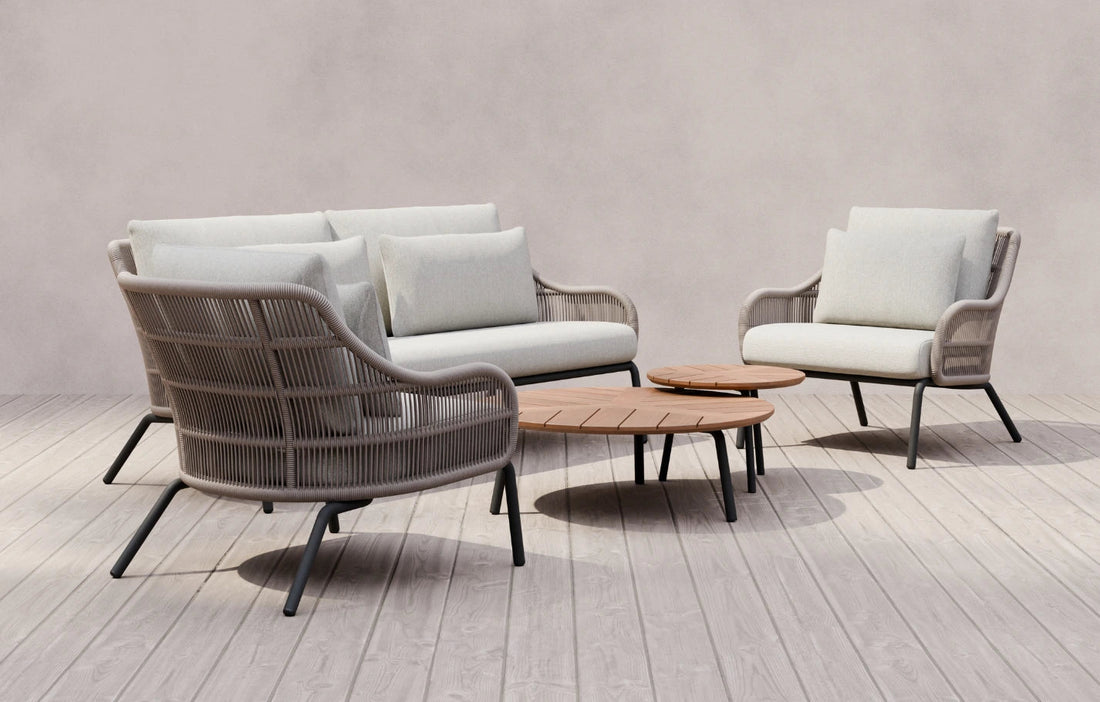
Synthetic Rattan vs Rope Garden Furniture: Which Outdoor Trend Is Just Hype?
Share

Weaving through the marketing myths of garden lounge sets
Outdoor furniture trends move almost as fast as indoor ones.
One year it’s all about rattan garden sofas, the next it’s sleek “Scandi-style” rope chairs.
But behind the glossy catalogues and Instagram shots, how much of these trends are about performance—and how much is just hype?
Let’s unravel it.

Synthetic Rattan: The “Classic”
Synthetic (a.k.a. “all-weather”) rattan has dominated patios for over a decade. Retailers often describe it as durable, timeless, and “maintenance-free.”
What Are the Pros of Synthetic Rattan?
Withstands rain better than natural rattan
Woven over lightweight frames (often aluminium)
Still considered stylish and familiar
...And What are the Cons?
Not all synthetic rattans are equal—cheaper PVC versions crack and fade quickly under UV rays
If you buy a poor quality set it can be prone to loose weaves which sag over time if not properly tensioned
It can be vulnerable to damp, particularly if you leave your cushions on your furniture and they get damp
Insider Tip: Many mid-range rattan sets look identical to “luxury” versions. Sometimes the difference is marketing, not necessarily material quality.
The Undercover Furnisher
Rope Furniture: The New Darling of Outdoor Design
Rope furniture has exploded as the “modern alternative” to woven rattan. It’s marketed as fresh, minimalist, and more breathable in hot weather. Let's look into it a little closer...
What Are the Pros of Rope Garden Furniture?
Lightweight, airy aesthetic (great for small patios or balconies)
Quick-dry ropes can feel more comfortable in the heat
Pairs well with aluminium or teak frames for a designer look
...And What are the Cons?
Ropes may loosen and sag over time—especially if knotted rather than tightly wrapped
Unless treated, UV exposure fades colours and weakens fibres
Cheaper polyester ropes absorb water, leading to mould and fraying
Which Garden Furniture Material Lasts Longer in the Real World?
Well-made synthetic rattan (HDPE, tightly woven, on an aluminium frame): 5–10 years with care
Rope furniture (polypropylene or olefin rope, UV-protected, on aluminium/teak): 3–6 years before noticeable wear
Both look great in catalogues, but higher-grade synthetic rattan has a proven track record for surviving multiple seasons outdoors.

The Power of Marketing
Rope garden furniture's surging popularity is largely due to a couple of key features. Firstly, it photographs beautifully for ads and socials. Secondly, it keeps trends turning, nudging customers to “upgrade” to the latest look?
Sound familiar? It’s fashion logic applied to furniture.
Buying Smarter: What to Ask Before You Commit
What’s the rope made of? (Polypropylene or olefin are best in class)
Is the rattan HDPE or PVC? (HDPE is more durable outdoors)
What’s the frame? (Aluminium is rust-proof)
What’s the warranty?
Rope and Rattan Garden Furniture FAQs
Which is lower maintenance?
Synthetic rattan—especially if it’s HDPE. Rope may require regular tightening and show marks more easily.
Does rope furniture work by the pool?
Be careful- unless treated, rope furniture can run the risk of damage from chlorine and saltwater.
Will rope furniture go out of fashion?
Maybe! It’s a style trend—rattan, however, remains more “classic” in the garden furniture world. But ultimately, as long as you like the design it doesn't matter.

So What's the Bottom Line?
Both synthetic rattan and rope have their place.
If you want longevity and proven performance, high-quality rattan garden sofas still win.
If you’re chasing a design-forward look and don’t mind the possibility of replacing sooner, rope furniture can be a fun seasonal style.



